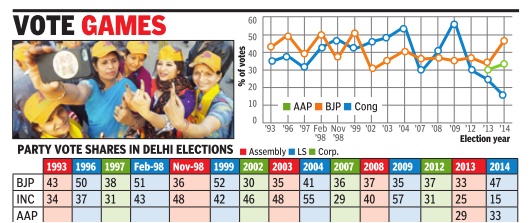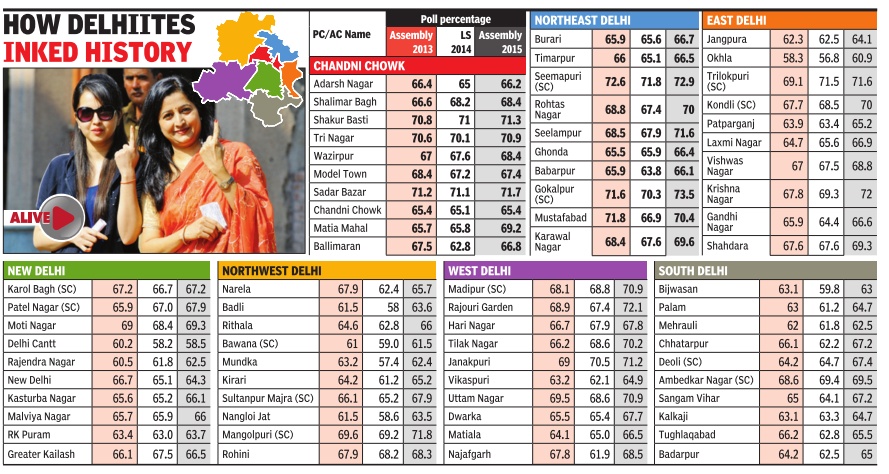Delhi: Assembly elections
(→winter session longest in history) |
(→2015) |
||
| (One intermediate revision by one user not shown) | |||
| Line 36: | Line 36: | ||
[[File: delhi assembly elections.jpg| Delhi:Assembly elections:2013, Lok Sabha elections:2014, [http://epaperbeta.timesofindia.com//Gallery.aspx?id=13_01_2015_002_027_002&type=P&artUrl=CAPITALS-CHANGING-LANDSCAPE-13012015002027&eid=31808 ''The Times of India''] |frame|500px]] | [[File: delhi assembly elections.jpg| Delhi:Assembly elections:2013, Lok Sabha elections:2014, [http://epaperbeta.timesofindia.com//Gallery.aspx?id=13_01_2015_002_027_002&type=P&artUrl=CAPITALS-CHANGING-LANDSCAPE-13012015002027&eid=31808 ''The Times of India''] |frame|500px]] | ||
See graphic 'Delhi:Assembly elections:2013, Lok Sabha elections:2014' | See graphic 'Delhi:Assembly elections:2013, Lok Sabha elections:2014' | ||
| − | |||
| − | |||
| − | |||
| − | |||
| − | |||
| − | |||
| − | |||
| − | |||
| − | |||
| − | |||
| − | |||
| − | |||
| − | |||
| − | |||
Revision as of 08:23, 19 August 2017
This is a collection of articles archived for the excellence of their content. |
1993-2014: Shifting political loyalties

Vote pattern: How Delhi has been the sultan of swing
Subodh Varma The Times of India
Between 1993 and 2014 Delhi voted for 16 times . That's an election almost every 16 months.Starting 1993, there've been six Assembly elections (1993, 1998, 2003, 2008, 2013 and 2015), six LS polls (1996, 1998, 1999, 2004, 2009 and 2014) and four civic elections (1997, 2002, 2007 and 2012).
A look at the vote shares of parties over these 16 elections shows a seeming unpredictability and a tendency to flip parties. This isn't evident if you look at only one type of election, say assembly or corporation. Put all elections together and it shows.There's a desire to change, perhaps even to punish. Hubris doesn't go down well with Delhi, especially if it accompanies non-performance.In this heavily politicized city, the educated and young electorate makes the distinction between requirements of different levels of government.
Between 1993 and 1998, voters gave a long rope to the rising BJP . They won the first 1993 assembly election, got majority votes in 1996 LS, won the 1997 corporation and majority in the 1998 LS polls which saw the shortlived NDA government emerge at the center.
Then, something snapped.After giving over 50% votes to BJP in the February 1998 LS elections, Delhi switched. The same November, it defeated BJP in the state elections, giving Shiela Dixit-led Congress their first government.
Months later, in 1999, Del hi again voted BJP in the LS elections. Vajpayee formed government at the Center.Three years later, in the 2002 civic polls, Delhiites defeated BJP and brought Congress.Next year, they again voted Congress in the assembly .Then, in the 2004 LS polls, the Capital went with Congress, giving them over 55% votes.
Three years later, Delhi tired of Congress and voted BJP back into the corporation. But in the 2008 assembly, Congress won a record third time. The Congress honeymoon continued in the 2009 LS elections, the party getting 57% votes. It took three years for another switch to happen--BJP won the 2012 civic polls.
This switching around might seem fickle. Actually , it's a flailing between the two options available. In a two horse race, Delhi-wallahs exercised the whip to punish non-performance. Finally , in 2013, hubris met its nemesis. The two dominant parties that had, between them, ruled Delhi at all levels for two decades faced a challenger, Aam Aadmi Party .BJP , which was again rising, had expected a rebound from the moribund Congress but AAP walked away with over 29% votes and Congress dipped to its all-time low of 25% vote share in the Assembly elections.
Knowing that AAP wasn't a serious contender for the Centre, and tired of Congress, Delhi voted BJP in 2014 LS, giving it 46% votes. AAP increased its vote to 33%. Congress plummeted to an alltime low of 15%.
2013 and 2014: Political changes

See graphic 'Delhi:Assembly elections:2013, Lok Sabha elections:2014'
